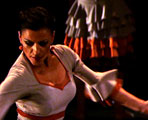Tuesday, September 18th, 2012. 9:00pm. 2100h. Teatro Central
Special 17 Bienal de Flamenco de Sevilla – All the information
Text: Estela Zatania
Photos: La Bienal
Back to school with an enlightening work
Directors and choreography: Manuel Liñán, Daniel Doña. Corps de ballet: Elisa Suárez, Jesús Fernández, Estíbaliz Barroso, Jonathan Miró, Agueda García de Saavedra, Cristián Martín, Anabel Moreno, Hugo López, Lucía Guarnido, Adrián Santana. Cante: Juan Debel. Guitar: Arcadio Marín.
After an excellent acoustic recital by Jerez singer Miguel Lavi with Manuel Parrilla on guitar at the intimate Espacio Santa Clara, we got to the Teatro Central, the venue regularly reserved for the most contemporary or experimental shows of the Bienal de Flamenco de Sevilla.
Nowadays it’s fashionable in flamenco to search for the “roots”. It’s an odd dichotomy: the word “pure” has become something lower than a curse word, never to be spoken in public…before you know it there’ll be a bill to impose sanctions against its use. And yet, everyone’s yearning to discover the “roots”. Darned if I get it.
This new work of Manuel Liñán and Daniel Doña, two young but seasoned veterans of flamenco and Spanish dance respectively, aims to teach us, in and hour and a quarter, “the indissoluble relationship between flamenco and Spanish dance” according to the program I scrupulously avoided reading until after the show in order to pre-empt possible intellectual contamination.
“<
It’s a pity they chose not to participate actively. There are some brilliant moments, but you miss a center of attention, a main figure who may be admired above the rest. The corps de ballet is well-prepared and of high quality, but the collective choreographies leave the senses anesthetized after three quarters of an hour, and even the technical perfection becomes boring. A wardrobe of beige, sepia and shades of grey throughout the work seems to suggest antiquity and old photographs, but serves to further reinforce the flatness of the work.
Without a doubt this is a carefully crafted work. The noteworthy choreographies are a far cry from the typical arrangement of “everyone dancing to the audience”, and the transitions are well-done. Particularly brilliant was one piece in which dancers appear on either side of the stage: at one side, we see folkloric seguidillas, and on the other, a very flamenco interpretation of sevillanas. They end forming “mixed” couples for a spectacular finish in the final verse, and the perfect compatibility lays out an important chapter of dance history.
A zapateado, with the seldom-heard “campanas” section, with five male dancers is another unforgettable choreographic success that gives new life to a nearly obsolete dance.
We are also served snippets of el vito, zorongo, primitive verdiales and fandangos, fandangos de Huelva with castanets and no guitar, pregón, soleá apolá, caña, romances and alegrías among other fragments, and the “Decálogo” of Vicente Escudero is read and illustrated…an authentic crash-course. Personally, the learning experience confirmed what I’ve always known: the spirit of flamenco, its essence and identity, has nothing at all to do with so-called pre-flamenco. There is a shared history, steps, music and techniques, but no shared perspective. If flamenco is edgy, dry, aggressive, biting or provocative, the “pre” dances are rich in sweetness, beauty, light and even innocence. They are diametrically opposed undertakings.
Oddly enough, in the historic journey, we are never brought to the present day. In fact, we barely make it to the nineteen-seventies. This is where Liñán’s appearance with his luminous contemporary style would have been the perfect crowning touch.
Noteworthy was Jesús Fernández who had some fine solo spots although he does not appear on the program as soloist, and the incredibly versatile singer…just one, like it used to be in the large companies…Juan Debel, who, without being Manuel Torre did a fine job with the dizzying variety of music he managed with credibility and knowledge.
